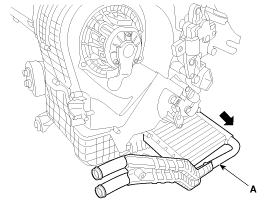|
1. |
Disconnect the negative (-) battery terminal.
|
|
2. |
Remove the heater and blower assembly.
(Refer to Heater -"Heater Unit")
|
|
3. |
Remove the heater core cover (A) after loosening the mounting
screws.

|
|
4. |
Pull out the heater core (A) from the heater unit.

|
|
5. |
Install in the reverse order of removal.
| A. |
If you're installing a new heater core, add refrigerant
oil (PAG OIL).
|
| B. |
Replace the O-rings with new ones at each fitting, and
apply a thin coat of refrigerant oil before installing them.
Be sure to use the right O-rings for R-134a to avoid leakage.
|
| C. |
Immediately after using the oil, replace the cap on the
container, and seal it to avoid moisture absorption.
|
| D. |
Do not spill the refrigerant oil on the vehicle; it may
damage the paint; if the refrigerant oil contacts the paint,
wash it off immediately.
|
| E. |
Apply sealant to the grommets.
|
| F. |
Make sure that there is no air leakage.
|
| G. |
Charge the system and test its performance.
|
| H. |
Do not interchange the inlet and outlet heater hoses and
install the hose clamps securely.
|
| I. |
Refill the cooling system with engine coolant.
|
|
1.
Disconnect the negative (-) battery terminal.
2.
Recover the refrigerant with a recovery/recycling/charging station.
3.
...
1.
Disconnect the negative (-) battery terminal.
2.
Remove the heater and blower assembly.
(Refer to Heater -"Heater Unit")
...
 Kia Soul: Heater Core Replacement
Kia Soul: Heater Core Replacement Heater Unit Replacement
Heater Unit Replacement Evaporator Core Replacement
Evaporator Core Replacement

